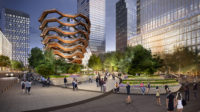Rival Proposals for Hudson Yards Discussed

Rival Proposals for Hudson Yards Discussed
Brookfield Properties’ proposal, led by Skidmore, Owings, and Merrill and Field Operations, with a large group of contributors including SHoP Architects, Diller Scofidio + Renfro, and SANAA.
Image: Courtesy Brookfield Properties

Rival Proposals for Hudson Yards Discussed
Brookfield Properties’ proposal, led by Skidmore, Owings, and Merrill and Field Operations, with a large group of contributors including SHoP Architects, Diller Scofidio + Renfro, and SANAA.
Image: Courtesy Brookfield Properties

Rival Proposals for Hudson Yards Discussed
FXFowle, Pelli Clarke Pelli, and WRT partnered on a proposal from the Durst Organization and Vornado Realty Trust.
Image: Courtesy Durst Organization and Vornado Realty Trust

Rival Proposals for Hudson Yards Discussed
FXFowle, Pelli Clarke Pelli, and WRT partnered on a proposal from the Durst Organization and Vornado Realty Trust.
Image: Courtesy Durst Organization and Vornado Realty Trust

Rival Proposals for Hudson Yards Discussed
Steven Holl is working with Extell Development Company.
Image: Courtesy Extell Development Company

Rival Proposals for Hudson Yards Discussed
Steven Holl is working with Extell Development Company.
Image: Courtesy Extell Development Company

Rival Proposals for Hudson Yards Discussed
Kohn Pedersen Fox, Arquitectonica, Robert A.M. Stern, and West 8 collaborated on the proposal from the Related Companies and Goldman Sachs.
Image: Courtesy Related Companies

Rival Proposals for Hudson Yards Discussed
Kohn Pedersen Fox, Arquitectonica, Robert A.M. Stern, and West 8 collaborated on the proposal from the Related Companies and Goldman Sachs.
Image: Courtesy Related Companies

Rival Proposals for Hudson Yards Discussed
The Tishman Speyer and Morgan Stanley proposal, designed by Helmut Jahn and Peter Walker.
Image: Courtesy Tishman Speyer

Rival Proposals for Hudson Yards Discussed
The Tishman Speyer and Morgan Stanley proposal, designed by Helmut Jahn and Peter Walker.
Image: Courtesy Tishman Speyer



Post a comment to this article
Report Abusive Comment